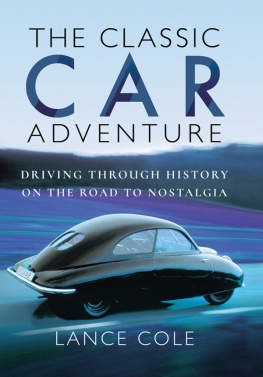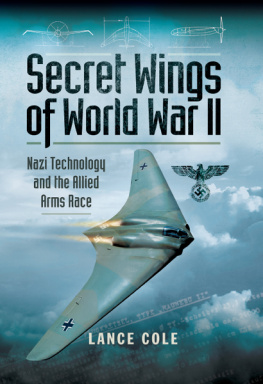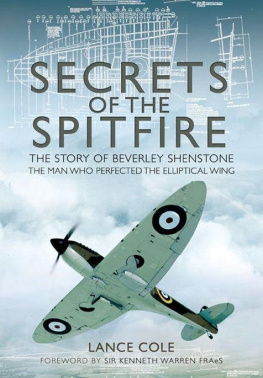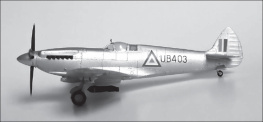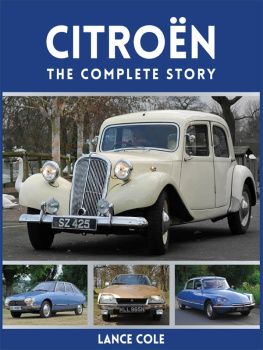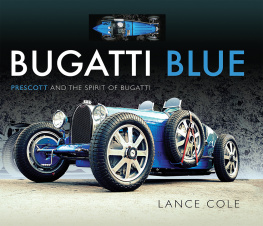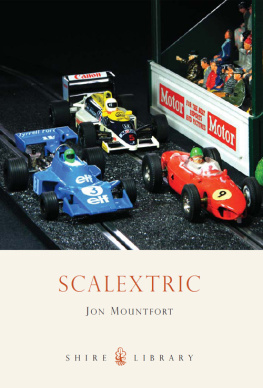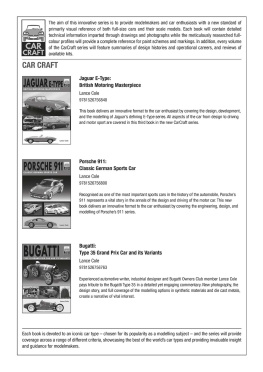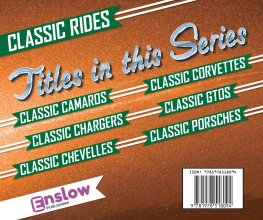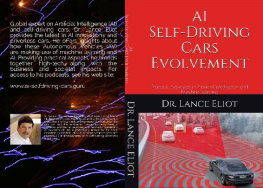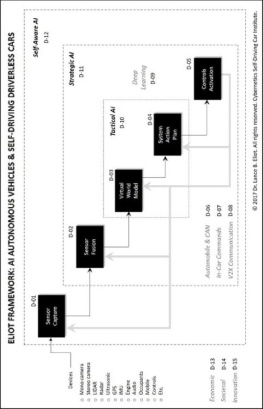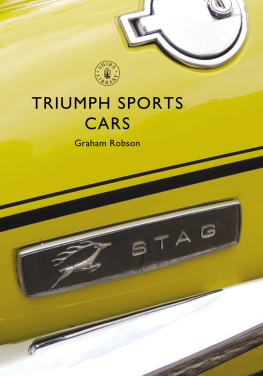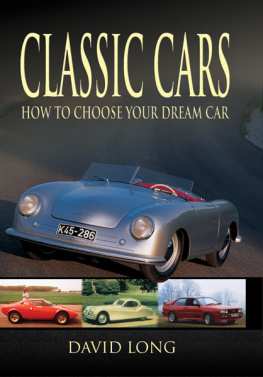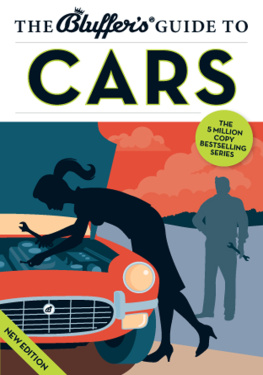
THE CLASSIC
CAR
ADVENTURE
THE CLASSIC
CAR
ADVENTURE
DRIVING THROUGH HISTORY ON THE ROAD TO NOSTALGIA
LANCE COLE

Also by this author (non-fiction)
Secrets of the Spitfire
Secret Wings of World War II
VC10: BOAC, Boeing and a Jet Age Battle
Vickers VC10
Saab Cars The Complete Story
Saab 99 and 900
Citron The Complete Story
Long Haul
Heavies
The New Illustrated Encyclopaedia of the Automobile
First published in Great Britain in 2017 by
Pen & Sword Transport
an imprint of
Pen & Sword Books Ltd,
47 Church Street,
Barnsley,
South Yorkshire.
S70 2AS
Copyright Lance Cole, 2017
A CIP record for this book is available from the British Library.
ISBN 978 1 47389 641 3
eISBN 978 1 47389 643 7
Mobi ISBN 978 1 47389 642 0
The right of Lance Cole to be identified as Author of this Work has been asserted by him in accordance with the Copyright, Designs and Patents Act 1988.
All rights reserved. No part of this book may be reproduced or transmitted in any form or by any means, electronic or mechanical including photocopying, recording or by any information storage and retrieval system, without permission from the Publisher in writing.
Pen & Sword Books Ltd incorporates the Imprints of Pen & Sword Aviation, Pen & Sword Maritime, Pen & Sword Military, Wharncliffe Local History, Pen & Sword Select, Pen & Sword Military Classics and Leo Cooper.
For a complete list of Pen & Sword titles please contact
Pen & Sword Books Limited
47 Church Street, Barnsley, South Yorkshire, S70 2AS, England
E-mail:
Website: www.pen-and-sword.co.uk
Acknowledgements
This book is a collation of classic car moments taken from the three decades of motoring writing and driving that I have been fortunate enough to experience since winning the 1983 Sir William Lyons Guild of Motoring Writers Award the key to the door for which I remain so grateful. Along the way I have received help from many people and would like to thank them for assisting me in my annoying youth and in my more recent maturity as I enter old git territory. I owe a debt to a host of classic car, car design, and motoring writing people who it has been my privilege to encounter or know. They know who they are. Thanks also to The Daily Telegraph , The Independent , The Automobile , The South China Morning Post , Autocar , Classic Cars , Hemmings Sports and Exotic Car , Classic Car Weekly , Saabs United, Haymarket, the Crowood Press, Pen and Sword Books, and the other publications that have commissioned and printed my words and pictures over the years. Original versions of some of the words herein were previously published by: The Daily Telegraph Motoring , the Independent , the Automobile, Classic Cars, Crowood Press, and Pen and Sword. A younger (pre- Octane fame) David Lillywhite gave me my opportunity at Classic Cars magazine many years ago, and I thank him. Paul Hudson made space for classic cars and my words about them at the Daily Telegraph . Sean OGrady did likewise at the Independent . Richard Gunn and James Walshe both noted motoring writers have been of encouragement and help with some of the conversation in this book, as has Mark McCourt at Americas Sports and Exotic Car. I offer appreciation to my classic car friends at the Allard Owners Club, Porsche GB and Porsche Club GB, the Bugatti Trust, the Bristol Owners Club, various Citronistes, Robin Morley, the Saab Owners Club, Autofarm, Dick Lovett. I owe Bjorn Envall my thanks and respect. Thanks also to the Royal College of Art Vehicle Design Unit and certain tutors for allowing me access over the years. My thanks and admiration for Allard days go to Allan Allard, Mike Knapman, Blair Shenstone, Dave Loveys. My gratitude for great drives and friendship to John Hole. A salute also to Michael Read classic car enthusiast, friend and owner of Charlotte the Chenard.
Dedication
To unsung heroes
Also for Emily and Jack, in the hope that you are seekers beyond the constraints of the conditioned mind
Introduction
Vintagent to Modern Classic
Nostalgia is better than it used to be and in the world of old cars, nostalgia is an engaging and addictive passion. Yet the term classic car means different things to different people, be that an early veteran car from circa 1905, a pre-1930s vintage affair a vintagent car a 1940s-1970s classic, or 1980s modern classic; each strain or tribe of the old car movement has its devotees and dedicated inhabitants. Some people love cars across all these groups, others only have interest in one era or one specific marque. Whatever their differences, all share the great enthusiasm, the great affection for inanimate lumps of metal that seem to have far more personality than normal psychiatry might admit, and certainly far more character than todays new cars. The psychometry of the classic car is an intriguing story. Between these pages cars appear without hierarchy. Space precludes including every classic car, but does permit a subjective journey through the classic years of steel and glass-fibre that gave us so much in a time before todays anodyne amalgam of what we call the modern motor car. Because we can now see that from the late 1920s to the late 1970s, car design gave us much, it is possible to look back to days when cars were cars, men were allowed to be men (within the bounds of responsible behaviour) and health and safety, political correctness, and the court of public opinion did not dictate design.
Back before all this transpired, car designers and engineers could think freely and individually, rather than conforming as so many of them now have to (or are educated to do so) in a prescribed fashion of the passing moment set down by apparent preachers of perceived opinion dressed as fact. True, a lot of people died in cars, but so did they horse riding, flying, or playing rugby. Above all, earlier cars were the essence of something vital in society. That may not be so true of todays new cars.
The excitement of early cars 1905-1939 was possibly mirrored in a different context by the cars of the 1940s-1970s, but then things began to change. Perhaps we ought to say in generalisation that the contemporary classic car movement frames a love of products framed from about 1945 onwards, but in the four decades before that, a great era of cars ruled and we should not forget them or their owners within our perceived classic movement. According to the Federation of British Historic Vehicle Clubs current report, forty eight per cent of the British population think that historic vehicles (built prior to 1985) should be preserved for the future. Throw in the Fdration Internationale des Vhicules Anciens, add, North American, Australian, Asian, African, European, and South American classic car enthusiasms, and the true scale and value of our love of old cars is obvious. This is a global addiction and an adventure in a great story amid marque mania.
America categorises its classic cars as Antique (pre-1930), Edwardian, Vintage and Pioneer, amid varying subsets and dates. Germans and other northern Europeans refer to Oldtimers and Youngtimers. Whatever such definitions and tags, surely all old cars can be utterly classic irrespective of the foibles of time, age and opinion. European and American car design may have taken different routes before the Second World War and after it, but this should not stop us supping at the cup of their respective delights simultaneously, should it? All over the world, old cars whatever their era are held in increasing esteem and, from here on in, I shall call them classic cars. They provide us with delights, disasters and, often, financial distress. It is a huge sphere and a global passion that breaks down boundaries and overcomes language and cultural barriers. Every television channel seems to have a classic car programme and even the Daily Telegraph has a classic cars column. New niches are emerging all the time enthusiasm for Eastern Bloc classics is rising, as is a burgeoning modern classics story, itself layered with subcultures ranging from Japanese supercars to rotary delights and 1980s European hot hatches. Neither should we forget that in America, Germany, France, Italy, or Japan, to be an engineer or industrial designer was to be a respected professional, whereas in Britain such professions were (and remain) subject to snobbery and a lack of respect for decades. Is this one reason why British engineering was allowed to wither?
Next page
